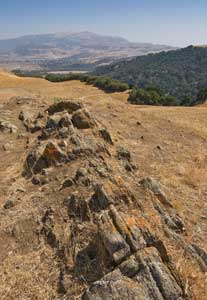I left (Pleasanton Ridge Regional Park) disappointed but also
feeling that I had not given it a fair look
During this difficult recession, it is a little surprising to think that during the depths of the Great Depression, 71 percent of the voters of Oakland and Berkeley chose to establish the first regional parks agency in the nation. Despite economic hardship, East Bay voters were willing to pay for the protection of the hills and open space around them.
The East Bay Regional Parks District has grown to encompass all of Alameda and Contra Costa counties and is the largest regional parks district in the nation. It includes 65 parks, 100,000 acres of land and more than 1,100 miles of trails.
Though I have lived most of my life in the Bay Area, my travels seem to take me through, but rarely to, the East Bay. Henry Coe State Park is nearby and so vast. The Santa Cruz Mountains that separate the peninsula and the South Bay from the coast have such variety and beauty on each side. These closer attractions always seem to trump the notion of getting out in the East Bay. I decided to venture outside my box and visit Pleasanton Ridge Regional Park.
One midday last week, I headed north on Interstate 680, crossed Sunol Grade and left the bay basin behind. Several miles past the first Sunol exit, I took the Sunol Boulevard/Castlewood Drive exit then turned left on Castlewood Drive. After another left at Foothill Road, I drove 1.6 miles to the well marked Oak Tree Staging area.
The parking area is on the valley floor, and, as the name Pleasanton Ridge suggests, it requires some climbing to see the show. A few hundred yards up Oak Tree Trail, a dirt road, I opted to take the Woodland Trail, a footpath that climbs gently through the shade of valley oaks and coast live oaks.
A half hour and about 700 vertical feet later, I reached the ridge crest. The widest view is to the south toward Mission Peak, San Antonio Reservoir and the Sunol/Ohlone Wilderness; all of which lie beyond the portion of Interstate 680 I traveled earlier. I had guessed there would be views of the bay on the ridge top, but Sunol Ridge parallels Pleasanton Ridge to the west and blocks a wider view.
While I can wear out a soapbox singing the praises of getting out into nature, this day and this park reminded me why summer in our area can sometimes be a disappointment. The Chamber of Commerce says the hills are golden, but they’re brown. The annual grasses and plants have gone to seed and months without rain leave the landscape lifeless and coated with windblown dust. Often, my steps sounded as though I was walking over corn flakes.
But then a surprise. Higher up this bare windblown ridge is a large grove of very happy and healthy olive trees. The grove’s presence here seems wildly out of place, and there is no record of its origin.
I wandered further up the ridge where views opened toward Mount Diablo and points east of Interstate 680. I returned to my car by the same route for a 4- to 5-mile walk in all.
I left this park disappointed but also feeling that I had not given it a fair look. The park is long and thin like a snake, and the only access point is the staging area at one end. One trail book I consulted suggested a 12-mile hike that only travels two-thirds of the way up the snake. On that walk, the trail drops down to Sinbad Creek, which divides Pleasanton Ridge from the higher Sunol Ridge to the west. Clearly, there is more variety here than I saw on my short ramble along the ridge crest.
The brochure brags of “an abundant variety of wildflowers,” and I’ll bet Sinbad Creek rocks in spring, too. I’ll be back for a longer hike then.








